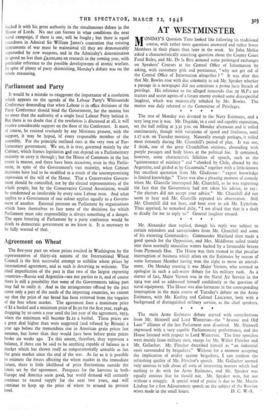Agreement on Wheat The five-year pact on wheat prices reached
in Washington by the representatives of thirty-six nations of the International Wheat Council is the first successful attempt to stabilise wheat prices by international agreement, and as such is deserving as welcome. The chief imperfection of the pact is that two of the largest exporting countries—Russia and Argentina—are not parties to it, and of course there is still a possibility that some of the Governments taking part may fail to ratify it. And as the arrangements offered by the pact cover only a part of the needs of the importing countries, we cannot say that the price of our bread has been removed from the vagaries of the free wheat market. The agreement fixes a maximum price of $2 a bushel and .a minimum price of Si.so for the first year, 1948-49, dropping by to cents a year until the last year of the agreement, 1953,
be
when the minimum will become $rao a bushel. These prices are a great deal higher than were suggested (and refused by Britain) a year ago before the tremendous rise in American grain prices last autumn, but lower than they would have been before-grain prices broke six weeks ago. To this extent, therefore, they represent a balance, if there can be said to be anything capable of balance in a market which has shown itself so temperamentally unstable as has the grain market since the end of the war. As far as it is possible to estimate the forces affecting the wheat market in the immediate future, there is little likelihood of price fluctuations outside the limits set by the' agreement. Prospects for the harvests in both Europe and America seem good, but world demand *ill certainly continue to exceed supply for the next two years, and will continue to keep up the price of wheat to around its present level.


































 Previous page
Previous page